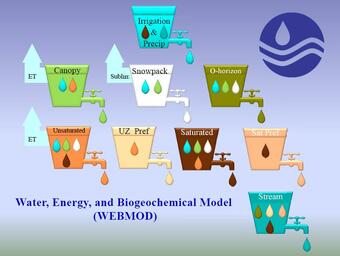Water, Energy, and Biogeochemical Model (WEBMOD)
OVERVIEW OF WEBMOD

The Water, Energy, and Biogeochemical Model (WEBMOD) uses the framework of the U.S. Geological Survey (USGS) Modular Modeling System (MMS) to simulate fluxes of water and solutes through watersheds. WEBMOD divides watersheds into model response units (MRU) where fluxes and reactions are simulated for the following eight hillslope reservoir types:
- canopy
- snowpack
- ponding on impervious surfaces
- O-horizon
- two reservoirs in the unsaturated zone, which represent preferential flow and matrix flow
- two reservoirs in the saturated zone, which also represent preferential flow and matrix flow
The reservoir representing ponding on impervious surfaces, currently not functional (2016), will be implemented once the model is applied to urban areas.
MRUs discharge to one or more stream reservoirs that flow to the outlet of the watershed. Hydrologic fluxes in the watershed are simulated by modules derived from the USGS Precipitation Runoff Modeling System; the National Weather Service SNOW-17 snow model; and a topography-driven hydrologic model (TOPMODEL). Modifications to the standard TOPMODEL include the addition of heterogeneous vertical infiltration rates; irrigation; lateral and vertical preferential flows through the unsaturated zone; pipe flow draining the saturated zone; gains and losses to regional aquifer systems; and the option to simulate baseflow discharge by using an exponential, parabolic, or linear decrease in transmissivity.
PHREEQC, an aqueous geochemical model, is incorporated to simulate chemical reactions as waters evaporate, mix, and react within the various reservoirs of the model. The reactions that can be specified for a reservoir include equilibrium reactions among water; minerals; surfaces; exchangers; and kinetic reactions such as kinetic mineral dissolution or precipitation, biologically mediated reactions, and radioactive decay. WEBMOD also simulates variations in the concentrations of the stable isotopes deuterium and oxygen-18 as a result of varying inputs, mixing, and evaporation.
The WEBMOD manual describes the WEBMOD input and output files, along with the algorithms and procedures used to simulate the hydrology and water quality in a watershed. Examples are presented that demonstrate hydrologic processes, weathering reactions, and isotopic evolution in an alpine watershed and the effect of irrigation on water flows and salinity in an intensively farmed agricultural area. The examples provide the user with templates to facilitate the modeling of other watersheds.
EXECUTABLES AND SOURCE CODE
WEBMOD 1.0 (compiled for Windows, 64-bit), GUI, and examples (38 MB)
WEBMOD 1.0 (compiled for Linux, 64-bit), GUI, and examples (37 MB)
Both compiled versions are built from the same source code: WEBMOD source code (38 MB).
ADDITIONAL INFORMATION
User Guides and Technical Information
Webb, R.M.T., and Parkhurst, D.L., 2017, Water, Energy, and Biogeochemical Model (WEBMOD), user’s manual, version 1: U.S. Geological Survey Techniques and Methods, book 6, chap. B35, 171 p., https://doi.org/10.3133/tm6B35
RELATED LINKS
- PHREEQC (Version 3)
- Precipitation Runoff Modeling System (PRMS Version 4)
- The GIS Weasel
- Simulating the variable-source-area concept of streamflow generation with the watershed model TOPMODEL Water-Resources Investigations Report 93-4124
- SNOW-17 Model
Citation Information
| Publication Year | 2018 |
|---|---|
| Title | Water, Energy, and Biogeochemical Model (WEBMOD) |
| Product Type | Software Release |
| Record Source | USGS Digital Object Identifier Catalog |

